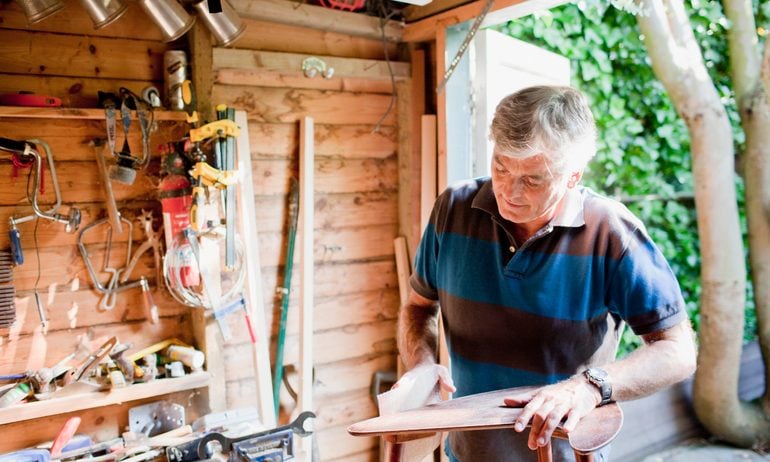Other Structures Coverage for Homeowners
Other structures coverage can pay for damage to items such as a fence, shed or detached garage.

Many, or all, of the products featured on this page are from our advertising partners who compensate us when you take certain actions on our website or click to take an action on their website. However, this does not influence our evaluations. Our opinions are our own. Here is a list of our partners and here's how we make money.
Other structures coverage is the section of a homeowners policy that pays if a fence, shed or other detached structure is damaged on your property.
Other structures insurance covers damage from causes such as fire, hail, wind and vandalism.
The limit for other structures coverage is generally set at 10% of your dwelling coverage limit.
Homeowners insurance covers not only your house but also other parts of your property. If lightning strikes your shed or a blizzard takes out part of your fence, the other structures coverage in your policy can help pay for the damage.
What is other structures coverage?
Other structures coverage pays for damage to structures on your property that aren’t attached to your house. (The house falls under your dwelling insurance.) This could include the following types of structures:
Fence.
Detached garage.
Shed.
Gazebo.
Guesthouse.
Driveway.
Dock.
Other structures insurance may also cover a swimming pool, but it’s worth checking with your insurer. Some companies include an in-ground pool under dwelling coverage instead of other structures, especially if it’s attached to your home by a walkway or enclosure. If you have a portable above-ground pool that you could take with you to another home, it might fall under personal property coverage.
Why should you care which part of your policy covers your pool? Because replacing a damaged pool can be expensive, you’ll want to make sure the appropriate section of your policy has a limit high enough to cover it.
Other structures coverage pays only for the damaged structures themselves — not for anything stored inside. Say your shed catches fire and everything inside it is destroyed, including a bunch of tools and gardening supplies. Other structures coverage would pay to rebuild the shed, but your personal property insurance would cover the items inside.
Your homeowners insurance deductible generally applies to other structures coverage. (A deductible is the amount of a claim you’re responsible for.) Here’s how it works: A storm does $5,000 worth of damage to your detached garage, and your deductible is $1,000. Your insurer would pay $4,000 toward repairs.
Is other structures coverage required?
You’re not legally required to buy other structures coverage. However, most mortgage lenders require borrowers to have homeowners insurance, which almost always includes other structures coverage.
If your mortgage is paid off or you’re paying cash for your home, you could go without homeowners insurance. But doing so may not be worth the risk if you don’t have the financial resources to rebuild your home after a disaster.
What does other structures insurance cover?
The other structures on your property are usually covered for the same disasters that your house is, including fire, hail, wind and vandalism. Most homeowners policies cover your house and other structures on an “open perils” basis, meaning that as long as your policy doesn't specifically exclude a given problem, it’s covered.
In rare cases, your homeowners policy may cover other structures on a “named perils” basis instead, meaning your policy will cover only disasters it specifically lists. These typically include:
Fire or lightning.
Windstorm or hail.
Explosion.
Riot or civil commotion.
Smoke.
Vandalism or malicious mischief.
Theft.
Volcanic eruption.
A falling object.
The weight of ice, snow or sleet.
Accidental discharge of water or steam.
Sudden and accidental tearing apart, cracking, burning or bulging.
Freezing of certain household systems or appliances.
Certain sudden, accidental damage from artificially generated electric currents.
Damage caused by vehicles or aircraft.
Not sure which type of homeowners policy you have or which perils it covers? Check with your agent or call your insurer.
What does other structures insurance not cover?
Most homeowners policies have a detailed list of things they won’t cover. Here are a few of the most common.
Flooding
If heavy rain or an overflowing river sends water seeping into your shed, a standard homeowners policy won't cover the damage. Homeowners in at-risk areas should look into flood insurance, which is available through the federal government and private insurers. Note that federal coverage for other structures may be limited.
Earthquakes and other earth movement
Most homeowners policies rule out coverage for various types of “earth movement” such as earthquakes, sinkholes, landslides and mudslides. You may be able to buy extra coverage for these disasters.
Structures used for business
If you use your shed primarily to store equipment for your landscaping company or you run a small shop out of your guesthouse, your homeowners policy likely won't cover those structures. Instead, you may need business insurance.
Routine wear and tear
Insurance is designed as a financial safety net for sudden, accidental problems — not to cover standard home maintenance. So it’s unlikely to help if your aging fence starts rotting or the shingles on your detached garage wear out.
Infestations
Insurers consider preventing damage by termites, mice and other pests to be part of routine maintenance. That means your policy generally won’t pay to clean up infestations or repair any associated damage.
How much other structures coverage do I need?
Many insurance companies set your other structures coverage at 10% of your dwelling coverage limit. So if your dwelling is insured for $300,000, you’d have $30,000 of other structures coverage.
The default amount may not be right for you. If you have an in-ground pool and a large shed, for instance, $30,000 might not be enough to replace them if they’re destroyed. Speak with your agent or insurance company representative if you need to adjust your other structures coverage limit.
How much does other structures coverage cost?
Most people get other structures coverage as part of a homeowners insurance policy. The average cost of homeowners insurance in the U.S. is $2,110 per year, according to NerdWallet’s rate analysis. Your rate will vary based on where you live and how much coverage you need. Find the cheapest homeowners insurance.
NerdWallet calculated median rates for 40-year-old homeowners from various insurance companies in the 25 largest cities in each state by population. All rates are rounded to the nearest $5.
Sample homeowners were nonsmokers with good credit living in a single-family, two-story home built in 1984. They had a $1,000 deductible and the following coverage limits:
$300,000 in dwelling coverage.
$30,000 in other structures coverage.
$150,000 in personal property coverage.
$60,000 in loss of use coverage.
$300,000 in liability coverage.
$1,000 in medical payments coverage.
We made minor changes to the sample policy in cases where rates for the above coverage limits or deductibles weren’t available.
These are sample rates generated through Quadrant Information Services. Your own rates will be different.






